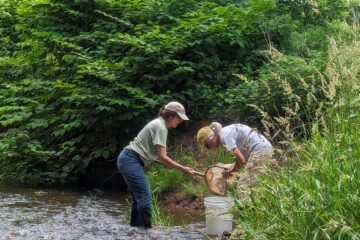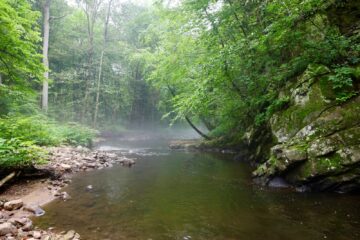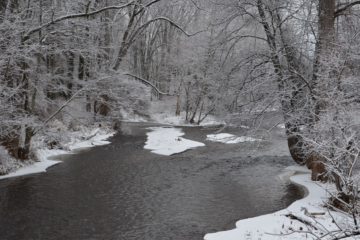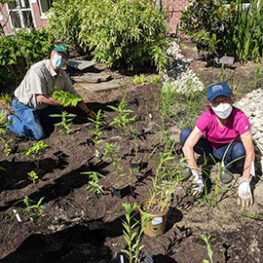
Peter Birnbaum (left), Cooper’s Hollow Farm and Bernardsville Environmental Commission, and Rosalie Ballantine, Bernardsville EC
A rain garden designed to remove an average of 25,000 gallons per year from the borough’s storm drainage system – and the Mine Brook – was installed outside the Bernardsville Public Library by a partnership of Raritan Headwaters Association (RHA), the borough Environmental Commission and Department of Public Works, the library and Rutgers University’s Water Resources Program.
The 140-square-foot garden was installed on June 15 and 16 to the right of the library’s main entrance. It is planted with native perennial flowers and shrubs, and will act as a basin to capture water draining from part of the building’s roof during storms.
“It’s beautiful,” said Dr. Kristi MacDonald, science director for Bedminster-based Raritan Headwaters, the region’s watershed watchdog. “It came out really nice and is a great example of a successful partnership.”
“This project reflects the commitment of the Borough to improving the water quality of our rivers and streams,” said Mayor Mary Jane Canose, “and I applaud the efforts of the Environmental Commission, our Public Works Department, our library and Raritan Headwaters for working collaboratively to bring it to fruition.”
“Stormwater is the biggest source of water pollution in New Jersey,” added Dr. MacDonald, a member of the borough Environmental Commission. “If we can do many more of these projects in Bernardsville and throughout the watershed, it would greatly reduce pollution in our streams and rivers.”
According to Dr. MacDonald, forests and wetlands naturally remove pollutants from water by allowing the water to infiltrate and move slowly into the ground and into streams. But with increasing development over the past century, old-fashioned drainage systems were designed to move rainwater off a site as quickly as possible, dumping pollutants such as fertilizers, pesticides, bacteria and oil into rivers and streams.
In contrast, she said, “this rain garden and other green infrastructure projects are like going back to having nature clean the water for us.”
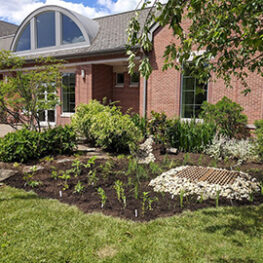 Native New Jersey plants used in the rain garden include blue flag iris (Iris versicolor), cardinal flower (Lobelia cardinalis), swamp milkweed (Asclepias incarnata), tall coneflower (Rudhbeckia laciniate), bee balm (Monarda fistulosa), Grays sedge (Carex grayi), squarose sedge (Carex squarrosa), and steeplebush or meadowsweet (Spiraea tomentosa).
Native New Jersey plants used in the rain garden include blue flag iris (Iris versicolor), cardinal flower (Lobelia cardinalis), swamp milkweed (Asclepias incarnata), tall coneflower (Rudhbeckia laciniate), bee balm (Monarda fistulosa), Grays sedge (Carex grayi), squarose sedge (Carex squarrosa), and steeplebush or meadowsweet (Spiraea tomentosa).
In addition to soaking up rainwater draining from the library roof and protecting the Mine Brook, these native plants will need little maintenance and they provide the added benefit of giving food resources to bees, butterflies, birds and other native wildlife that rely on them.
Raritan Headwaters plans to partner with Bernardsville and Rutgers on building two more rain gardens later this summer at Nervine Park next to the municipal building, and more in the future. In addition, the partners will host a hands-on workshop for residents on how to design and build a rain garden on their property.
Dr. MacDonald hopes local residents will be inspired to build rain gardens on their own properties. “One of the things we want to emphasize is that anyone can do this at their home,” she said. “Raritan Headwaters and our partners are happy to provide advice to anyone interested in building their own rain garden.”
For more information about rain gardens, go to https://issuu.com/rutgerswater or https://www.raritanheadwaters.org/2020/04/27/native-plants-and-watershed-health/. Dr. MacDonald can be contacted at kmacdonald@raritanheadwaters.org.
The library rain garden was designed and installed in consultation with Dr. Christopher C. Obropta of the Rutgers Cooperative Extension Water Resources Program. A grant from the Association of New Jersey Environmental Commissions (ANJEC) defrayed part of the cost. Native plants were provided by Wild Ridge Plants in Alpha and Cooper’s Hollow Farm in Bernardsville.
About Raritan Headwaters
Raritan Headwaters has been working since 1959 to protect, preserve and improve water quality and other natural resources of the Raritan River headwaters region through science, education, advocacy, land preservation and stewardship. RHA’s 470-square-mile region provides clean drinking water to 300,000 residents of 38 municipalities in Somerset, Hunterdon and Morris counties and beyond to some 1.5 million homes and businesses in New Jersey’s densely populated urban areas.
To learn more about Raritan Headwaters and its programs, please visit www.raritanheadwaters.org or call 908-234-1852.

